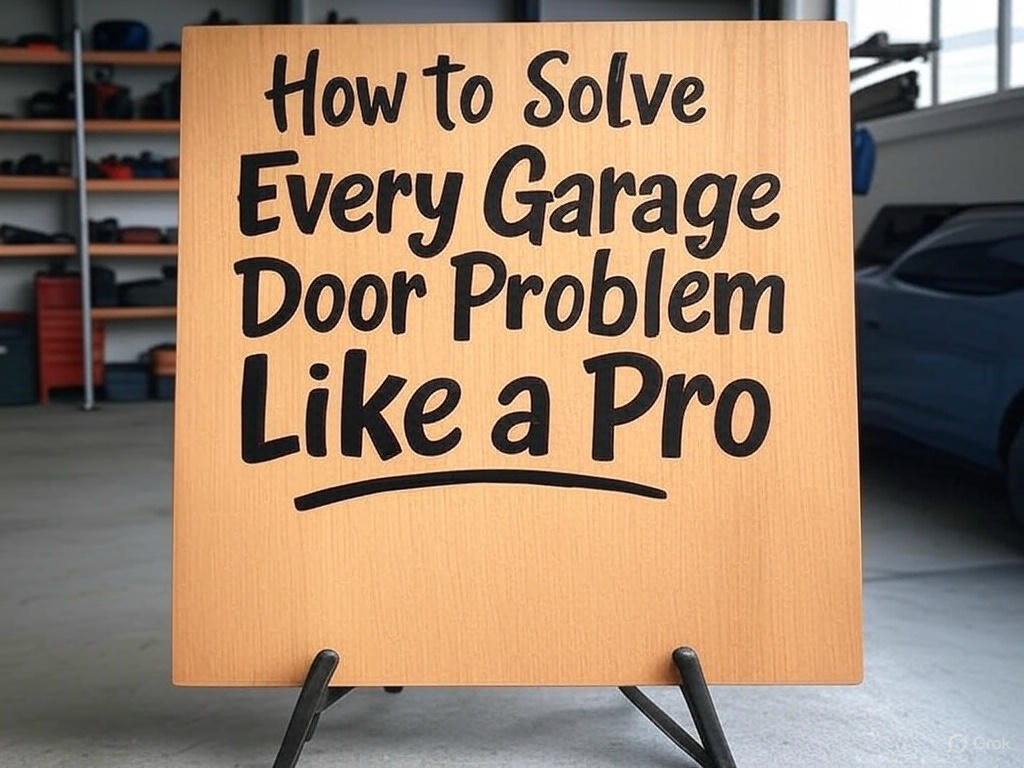Garage doors are an essential part of our daily lives, providing security, convenience, and protection for our vehicles and other belongings. However, like any other mechanical system, garage doors can experience problems. Understanding how to spot these issues early and knowing how to fix them can save you both time and money. In this article, we’ll cover common garage door problems, offer helpful solutions, and discuss when it’s time to call a professional.
Common Garage Door Problems and Their Solutions
Garage doors are complex systems with many moving parts. Here are some of the most common issues homeowners face, along with practical solutions you can try.
Broken Garage Door Springs: How to Replace Them Safely
One of the most common problems with garage doors is broken springs. These springs are responsible for helping your garage door open and close smoothly. If you hear a loud snap or the door refuses to open, one or both springs have likely broken.
Solution: Replacing garage door springs can be dangerous if you’re not familiar with the process. It’s important to let a professional handle the replacement. However, if you’re experienced with DIY repairs, you’ll need to release the tension on the springs carefully, remove the old ones, and install the new ones. Always wear safety gear and ensure the door is in a secure position.
Garage Door Not Opening: Quick Fixes to Try
A garage door that refuses to open can be frustrating, especially when you’re in a hurry. There are several potential causes for this issue.
Solution: First, check if the power to the garage door opener is on. If the opener is working but the door isn’t moving, inspect the garage door tracks for any debris or obstructions. You might also want to check the sensors at the bottom of the door to ensure they are aligned and free of dirt.
If everything looks good but the door still doesn’t open, it could be an issue with the opener itself or the door’s springs. In that case, calling a professional is recommended.
Misaligned Tracks: How to Fix Them
If your garage door is making strange noises or getting stuck while opening or closing, the tracks could be misaligned. Misaligned tracks can prevent the rollers from moving smoothly and cause wear and tear on other parts of the door.
Solution: Check the tracks for visible bends or misalignment. You can use a level to ensure the tracks are straight. If they are out of place, gently tap them back into position with a rubber mallet. Be sure not to damage the tracks, and ensure they are securely fastened to the wall. If you’re unsure, it’s best to call in a professional for a more thorough inspection.
Garage Door Opener Troubleshooting
Another common issue is with the garage door opener. These devices use a motor to lift and lower the door and can malfunction over time. Here’s how to troubleshoot.
Check the Remote and Wall Switch
Sometimes the issue is as simple as a dead battery in the remote or a faulty wall switch. Start by replacing the remote battery and checking if the wall switch is responsive. If neither works, the problem could lie within the opener’s electrical system.
Inspect the Motor Unit
If the opener motor makes a humming sound but the door doesn’t move, the issue could be a problem with the motor gears or a jam in the opener’s mechanism. In this case, you may need to remove the motor cover and inspect for any visible issues. If you’re unable to resolve the problem, a professional will be able to diagnose and repair the opener.
Preventive Maintenance for Garage Doors
Regular maintenance is essential for extending the life of your garage door and preventing costly repairs. Here are some simple steps to keep your garage door running smoothly.
Lubricate Moving Parts Regularly
Lubricating the springs, rollers, and hinges is a crucial part of garage door maintenance. Use a silicone-based lubricant, which will help reduce friction and wear. This simple task can prevent squeaks, extend the life of the parts, and reduce the chances of your door breaking down.
Check the Garage Door Sensors
The safety sensors located near the bottom of your garage door are vital for ensuring the door doesn’t close when something is in its path. Periodically check the sensors for alignment and clean them if dirt or debris has accumulated. Misaligned or dirty sensors can prevent the door from operating properly.
Inspect the Door’s Balance
To check the balance of your garage door, disconnect it from the opener by pulling the emergency release cord. Once the door is disconnected, lift it manually halfway. If it stays in place, the door is properly balanced. If it falls or rises on its own, it may be time to call a technician for an adjustment.
When to Call a Professional for Garage Door Repairs
Some garage door problems require the expertise of a trained professional. While many minor issues can be resolved with DIY solutions, more complex repairs are best left to the experts. Here’s when to call a professional:
Broken Springs
Garage door springs are under extreme tension and can be very dangerous to replace without the proper tools and experience. If you suspect a broken spring, it’s best to call a professional to ensure the job is done safely.
Opener Motor Problems
If your garage door opener is malfunctioning, a technician can diagnose and repair the electrical components of the motor. This may involve replacing the circuit board, motor, or other parts, which require specialized knowledge.
Track Issues or Misalignment
If your garage door tracks are severely misaligned or damaged, attempting to repair them yourself can cause further damage to the door. A professional can safely realign or replace the tracks, restoring the door’s functionality.
How to Save Money on Garage Door Repairs
While garage door repairs can be costly, there are ways to minimize expenses. Here are a few tips to help you save:
Regular Maintenance
Performing regular maintenance, such as lubricating moving parts and cleaning the sensors, can prevent many common issues from arising. This will help keep your door running smoothly and reduce the need for expensive repairs.
Catch Problems Early
The sooner you notice a problem with your garage door, the easier and cheaper it will be to fix. Whether it’s strange noises or a slow-moving door, addressing the issue quickly can help prevent more severe problems down the line.
Consider Repair Over Replacement
In some cases, a garage door can be repaired for a fraction of the cost of replacing it. Consult with a professional to assess whether your garage door can be repaired or if it’s time to invest in a new one.
Conclusion
A properly functioning garage door is essential for the security and convenience of your home. Whether you’re dealing with broken springs, misaligned tracks, or an unreliable opener, knowing how to troubleshoot and when to call in the experts can save you time, money, and stress. Regular maintenance is key to preventing future issues, ensuring your garage door continues to operate smoothly for years to come. Don’t hesitate to reach out to a professional when needed, and always prioritize safety during any DIY repairs.





